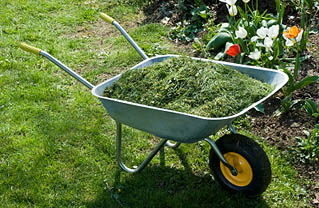When it comes to mowing the lawn, one of the biggest questions is whether or not to collect the clippings. Lawn clippings can be very beneficial to the lawn and it is recommended to leave the clippings in the lawn under most circumstances.
Proper Mowing
When the proper mowing schedule and lawn care program is followed, clippings will not harm the lawn. In fact, they will actually benefit the lawn. When mowing, a good rule of thumb is to never remove more than 1/3 of the grass blade. Cutting more than 1/3 of the blade off can stress the plant by reducing root growth that is essential for summer drought months. Unfortunately, during the spring rains, this means that the grass may need mowed every 3-4 days depending on how quickly it is growing. It is also crucial to remember to keep mower blades sharp. They need to be sharpened for every 8-10 hours of actual mowing time.
During the summer months, it is still a good idea to leave clippings in the lawn. Mowing time should be cut down to only once a week or possibly every 10-14 days. Cutting the lawn too short in the summer months can cause stress to the lawn as well as contribute to the browning that everyone tries to avoid.
Benefits of Not Collecting Clippings
- Recycling clippings back into the lawn improves lawn quality. Clippings return nutrients to the soil as they decompose.
- Clippings do not cause thatch. The belief that grass clippings cause thatch has been ruled out by recent research, which finds that thatch is composed mainly of grass roots.
- Recycling clippings is a responsible environment practice. Currently, landscape wastes, including clippings, account for almost 20% of all curbside waste.
- Clippings do not spread lawn diseases. Disease spores are present whether clippings are collected or returned.
- Recycling clippings saves time and extra work.
When to collect clippings
Grass clippings should only be collected if the grass is overgrown and large clumps have formed, covering portions of the lawn. Clippings should also be collected when a lawn disease is present in the lawn. Mowing and the spread of clippings contribute to the spread of lawn diseases.
Sum it up
Save yourself time and promote a healthier lawn by leaving the clippings where they lay. Mow on a regular schedule and mow as frequently or infrequently as possible for the time of the year and the weather conditions.
It is always a good idea to consult with a lawn care professional and ask any questions you may have. Look around, ask friends or family, and research companies on the Better Business Bureau to find a company that you can trust.

